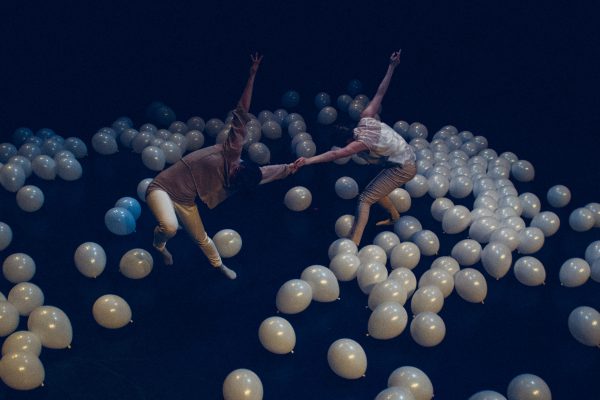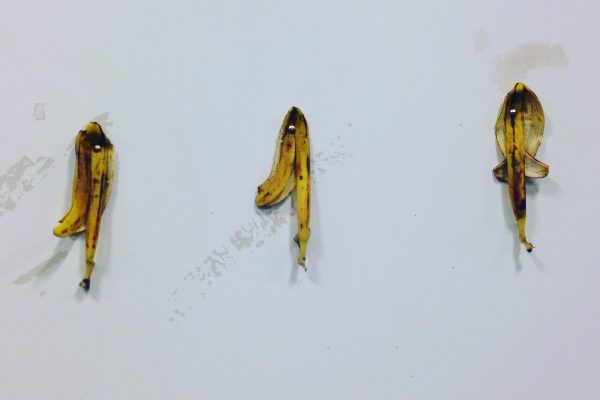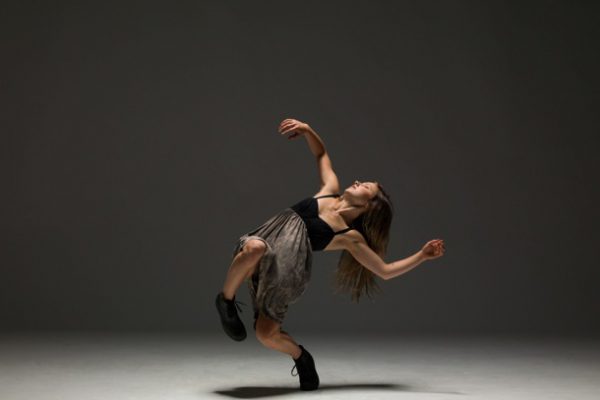It is a bright and hot July afternoon and Vancouver’s Chinatown has a sleepy yet content feel. Sidewalks are gently thrumming with activity: vegetables ripen under faded awnings; cold beads of water condense on cups of iced coffee held by young Vancouverites; a motorcycle growls around the corner of Main and Keefer. Up the steps to a former second-storey dim sum restaurant, we find Left of Main, an artist-run studio recently acquired and developed by contemporary dance company plastic orchid factory and shared with Tara Cheyenne Performance and MACHiNENOiSY. In the large white studio, an immersive dance installation is going on, drawing audience members (or participants) into a space distinct from yet porous with the street below.
To mark the ten-year anniversary of plastic orchid factory (POF), performers and directors Natalie LeFebvre Gnam and James Gnam designed a unique movement retrospective framed by the present — i miss doing nothing. The installation/performance ran each afternoon between 3 and 6pm for four days, July 11 through 14, creating a welcoming, casual atmosphere to enjoy and watch (no shoes allowed).
The lively outside world surrounding Left of Main is as prominent as the space within its four walls, influencing the set, the soundscore and the two dancers, as they physically revisit memories of work they have created together over the last decade. Aided by collaborators Nancy Tam (sound design), James Proudfoot and Vanessa Goodman (performer-devisers) and Paula Viitanen Aldazosa (installation design), the unique environment of i miss doing nothing shifts continually to respond to the light filtering in the windows and the sounds from the city outside — revealing, reflecting and mixing them together.
When I enter Left of Main, it is quiet. A handful of audience members are already seated around the perimeter of the studio, on chairs and the floor. As I settle, I notice Gnam in the centre of the studio, seemingly lost in thought. He reaches an arm behind him, balances on one leg for a moment and then recovers. LeFebvre Gnam kneels at the side of the room beside a window covered by a large white frame, with her head turned slightly as if listening. There are similar white frames around the room, some on wheels and some fitted over the large windows, each encasing a foil-covered panel. The afternoon light reflects off the foil surfaces in speckles and strips on the white floor, ceiling and walls. Something about the atmosphere is profoundly peaceful and meditative.
For the next few hours, the dancers shift individually between this memory dance — fragments or phrases — and states of rest. In the dance, their attention is removed from the audience, accessing memories far away from us. The imperfection of memory results in funny half dances, which are jarring, surprising and amusing to watch. When the dancers are at rest, they are fully present with the audience, making eye contact, soaking in the environment around them and noticing its features.
Dressed in black, Vanessa Goodman and James Proudfoot work together to intermittently transform the set: uncovering windows, wheeling frames around, moving foil panels or stacking frames together. I am struck with how versatile the set pieces are and how they can instantly change the space. I enjoy watching the work through the reflections on foil panels around the room or closing my eyes and guessing whether the sounds I hear are coming from outside or the speakers.
The soundscore is fabulously seamless, ebbing and flowing from eight speakers around the room. Nancy Tam sits at a desk in the corner, recording and mixing sounds picked up by microphones at each of the windows. When an ambulance goes by, the shrill siren is for once not a nuisance but a contributor. Several minutes later, I hear it exactly again, but this time recorded and played through a speaker on the other side of the room. The evolution of these recorded sounds, and sometimes music from past POF works or synthesized notes, adds to the pushing and pulling of time. It becomes unclear whether the ding-dong of the crosswalk I hear is in real-time or recorded half an hour earlier.
As the afternoon unfolds, I notice that the set changes occur in waves every half-hour or so. And each new configuration produces new architecture and possibilities to perceive how the dancers relate to each other and the room. At one point, all the frames are stacked together in the centre, forming a tall jagged installation that seems to dominate the space. Later, from my position on the floor, LeFebvre Gnam is only visible from the waist up, obscured by a single frame as if seen through a window. Captured in a memory, her arms stretch and bend individually, like a bird folding its wings. As she turns, two fingers delicately grasp an invisible cigarette.
The work is full of small interesting vignettes, happy products of cleverly devised performance elements and improvisation. As Gnam trembles in a difficult shoulderstand, arms reaching flat out behind him, LeFebvre Gnam stands watching in a beam of light, her focus soft. Later, as the soundscore grows to a blaring beat, Gnam performs a precarious tour of the room with one foot each on a white folding chair, as if wearing stilts or large shoes. Then for a while nothing happens, except the light gently shifting through the blinds. In these moments, I ask myself if I can stay present.
The program invites you to “observe your breath, allow your focus to wander, listen to the sounds above and behind you, be with moments of stillness, fatigue or boredom … do nothing.” In their promotion of the show, LeFebvre Gnam and Gnam asked, “Can we devise a piece that asks us to rediscover how to do nothing?” But what I see in i miss doing nothing is a commentary on time — our perception of it, our use of it and how it affects us. And though the work is full of interesting activity, the most intriguing and effective moments are the pauses and the silence. What stays with me is a memory of the physicality and attention of the performers as they listen, rest or watch each other.
As I sit and a gaze at a pink window logo refracted on the floor of the studio with sunlight (the mirrored word SEAFOOD and a Chinese symbol), I wonder if in this fast-paced age of ever-present technology whether our senses dull in order to keep up with it all. I wonder if we can learn to curate time and gain more out of each second. I wonder what doing nothing was like thirty years ago and whether with less information we had more experience.
~
A little goes a long way. Donate to The Dance Current today to support bold and inclusive coverage of dance in Canada.
Tagged: Contemporary, James Gnam, Natalie LeFebvre Gnam, BC





